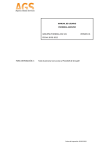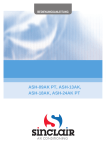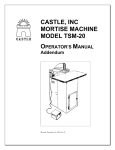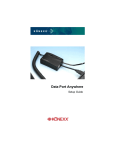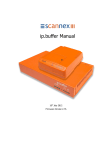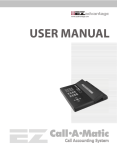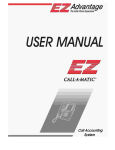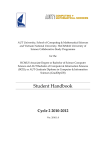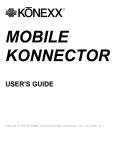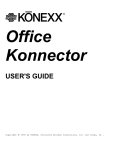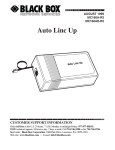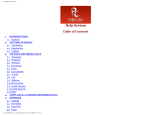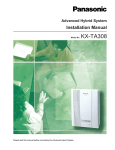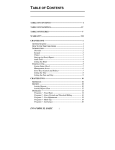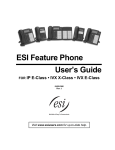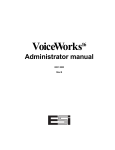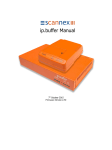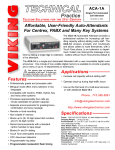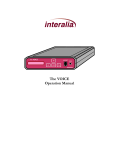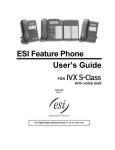Download Installation/User Manual
Transcript
PhoneBill MOTEL Installation/User Manual 0200-0050 Rev. B About ESI ESI (Estech Systems, Inc.) is a privately held corporation based in Plano, Texas, in the internationally known “Telecom Corridor.” Founded in 1987, ESI designs and builds innovative telecommunications products for businesses like yours. Because of their powerful combination of value and features, ESI products are consistently recognized by industry publications and leaders. In fact, ESI also creates telecommunications products for major companies to market under their well-known brand names. Copyright © 2000 ESI (Estech Systems, Inc.). Visit ESI on the Web at http://www.esi-estech.com. ESI is an ISO 9001-certified company. Table of Contents ...................................................................................... 1.1 .................................................................................. 2.1 .................................................................................................. 3.1 .......................................................................................... 4.1 ............................................................................................. 5.1 ............................................................................................................... 6.1 .............................................................................................7.1 ...................................................................................................... 8.1 (Warranty on opposite side of this page) WARRANTY In the event that this product proves to be defective in workmanship or materials within a period of one year from date of shipment, Estech Systems, Inc. (hereafter referred to as “ESI”) shall repair or replace the same at its option. Transportation will be the responsibility of the user/reseller. In no event shall ESI be liable for consequential or special damages, lost revenue, or user/reseller expenses arising out of or in connection with the use or performance of the product, whether based on contract, tort, or any other legal theory. The following shall void the above warranty: malfunctions resulting from fire, accident, neglect, abuse, or acts of God; use of improper electrical power; or repair of, tampering with or alteration of the products by anyone other than ESI-authorized personnel. Note: Failure to properly ground the system will void the warranty. PhoneBill Motel General Description PhoneBill is a small, inexpensive call accounting system that provides telephone call billing for the lodging industry. The system uses a combination of customer defined rates and call bands to determine the guest's charges. It prints all call records as occurred and/or on a room-by-room basis as guests check out. PhoneBill has record storage capacity ranging from 1,300 call records to 9,000 call records. The system is housed in a compact case designed for front desk use. It is powered by an external wall mount transformer. An on-board battery backs up all stored information and a grounding lug provides for static protection. The system has a serial inbound SMDR port, a parallel outbound printer port, a serial outbound printer port, and a 4 x 4 keypad for programming and attendant intervention. Up to 100 call records can be buffered if the printer is not available, is turned off, is out of paper, etc. PhoneBill receives serial call records from the PBX and based on the 1/0 prefix, length of the called numbers, and area code, will recognize the record as falling into one of 42 customer-defined bands. PhoneBill will apply the call duration against the corresponding customer programmed rate and bill the call. The resulting record is printed as completed and/or stored by room number for billing as guests check out. A credit limit per guest stay can be set individually or on a system-wide default basis to alarm the attendant and print a notice that a guest has exceeded his or her limit. Additionally, with the optional Toll Control feature, trunk access can automatically be allowed or denied on the Mitel SX20 or SX50 PBX. Five activity reports are available: Call Record: Prints each call as completed. Check Out/Guest Activity: Summary of all calls by guest. Credit Limit Notice: Alerts desk to guest exceeding credit limit. Guest Summary: Summary totals for all guests with active call records. Room Audit: Shows totals for guests checked-out plus grand total since last printed. Band Summary: Totals by band for number of calls, duration and amount for each band, plus grand total. System Costing Procedure PhoneBill's costing technique is based on the basic premise that long distance billing = distance × duration × rate. By dividing North America into groups or bands of area codes, and setting a billing rate for each band, PhoneBill can then calculate the billing of any call. PhoneBill has pre-defined bands for local calls, long distance within the home area code, 800 (including 888), 900, information, 976, and 0+; in addition to 14 undefined bands for 1+ long distance. At installation, the customer determines the number of long distance bands to be used and assigns the appropriate area codes to each. The bands are numbered 1 through 42. Each has a name (such as LD, LC, OPR), which may be preceded by a prefix (such as 1, 0, or 011), and can be further differentiated by the digits that make up the telephone number. Generally the bands in plain type in the following chart are pre-defined and only the bands shown below in bold type need to be programmed with area codes or exchanges. Bd Type 1 2 3 4-16 17 18 19 20 21 22 LC LD LC LD LD OPR INF 800 900 976 23 24-31 32 33-42 OPI INT INT SPL Prefix 1 1 1 0 1 1 01 011 011 Definition all 7 digit calls 1+7 digit long distance 10 digit local; list area codes: 1+10 digit long distance; list area codes: any 1 + 10 digit call not in above all 0+ calls 411, 1411, 15551212, 1XXX 5551212 [supersedes other fields] any 800 number (including 888) any 900 number 976, 1976, 1XXX976XXXX [supersedes other fields] (List additional special service exchanges) Operator-assisted international calls International calls beginning with 011 any 011 not listed above any combination of digits, area codes, exchanges per band 1.1 General Description PhoneBill Motel Establishing Long Distance Charges Use a standard North American area code map, as found in the front of most telephone directories, to help group U.S. area codes into common LD bands (4 through 17). By drawing in circular rings radiating out from your home city, you can easily group together the area codes with similar distances from your home city. See Band Programming Hints, page 1.4. Note: Previous versions of this manual included area codes with the map. However, with frequent area code changes and additions, this inclusion was no longer practical. Up-to-date area code information is available on the Web at http://www.555-1212.com (this Web location is subject to change; consult your preferred Web search engine if the location is no longer valid). Example: In Phoenix, the installer would call his long distance provider’s Customer Support and get costs for the first minute and each additional minute for calls to, say, these cities: Salt Lake City, Denver, Little Rock, Chicago, Honolulu, etc. The provider will need to know area codes and exchanges for each city; use past telephone bills to get this information, if necessary. Possible bands, then, for Phoenix might include (again, this is just an example): Band 1: local calls (not shown) Band 2: 1+ 7 digit long distance (not shown) Band 4: Long-distance calls within Arizona. Bands 5–8: Area codes for other states as shown. Area codes in Canada, Alaska, Bermuda, Hawaii, etc. would be grouped into several additional bands, depending on the rates to each area. Setting Rates Once the bands are defined, the customer decides the “rates” (including a mark-up) to apply to each band. For example, use $1.50 for the first minute, and 40¢ for each additional minute for Band 4, $1.65 and 45¢ for Band 5, and so on. Local, 800, 900, information bands, etc. are also rated. For local calls (Band 1), $.50 would be input for the first minute and 0¢ for each additional minute. The band definitions and rates can be changed at any time by the owner, who can input the password and add, delete or change any area codes, exchanges or rates. Modes of Operation The system software is divided into two sections; The Operating Mode and the System Programming Mode. • The Operating Mode is the day-to-day operations such as checking a guest out of the motel or changing a credit limit. • The System Programming Mode requires a password to enter and is the area of the software where the system program values are set or changed. Once set, these values will rarely need to be changed. 1.2 PhoneBill Motel General Description Keyboard Methodology Operating Mode When in the Operating Mode, the key combinations are as follows: Each operation begins with a function key (CHECK OUT, PRINT, CR LMT), followed by numeric keys (room number, report number or credit amount), followed by ENTER. A short beep indicates that the input has been accepted. A long beep indicates an input error. DELETE will return to the last time ENTER was input. Therefore, if a digit of a room number was input in error, touch DELETE, and begin again with the function key CHECK OUT. Programming Mode To access the System Programming Mode, the attendant keys-in ENTER, ENTER. The printer prompts that a password is needed. In the System Programming Mode, programming of the functions will begin with digits 71 and above, band definitions begin with a *, and Rate settings begin with a #. ENTER will confirm the input of a string of data. ENTER, ENTER will signify completion of programming in a particular function if it has more than one value entered. DELETE returns to the point where ENTER was last touched. ENTER, ENTER, ENTER will exit the programming section. One short beep indicates that an entry has been accepted, two short beeps signifies that a function or band section has been completed. Special Features Call Completion (Grace Period) PhoneBill (as other call accounting systems) assumes that a call has been completed when it has lasted for a certain period of time (the grace period). The grace periods preprogrammed are 75 seconds for international calls, 45 seconds for local/long distance calls and 15 seconds for information calls. These values can be changed in the programming mode. Shortening these values will assure that more “short” calls get counted, but will increase the chance that a call allowed to ring for a long period will be counted as a completed call. Lengthening the grace period will have the opposite effect. A policy should be considered that will forgive guest calls that are close to the periods indicated if the guest complains that he did not make a certain call. Even though PhoneBill gets precise durations on each call from the PBX, it rounds these up to the nearest minute for billing calculations and report totals. 976 Calls It is recommended that 976-type calls be blocked by the PBX. However, Band 22 is reserved for 976-type calls should this not be possible. Note that the charges for these calls may vary greatly depending on the type of 976 call. This band was included only to provide the information about the call so that, if not blocked by the PBX, it can be decided on a case-bycase basis how to bill for a 976 call. International Calls International calls are treated as a group in the same manner as long distance calls. Several bands can be set up in which countries with similar charges can be grouped together. Since International calls from anywhere in the U.S. to a particular country cost the same, seven International bands have been preprogrammed for country codes with similar costs. These are listed in Appendix 6. Band 32 is reserved for all 011 calls not assigned in Bands 23 through 31. Special Call Bands Though rarely needed, 10 Bands (33 through 42) are reserved for other special type calls to specific numbers, exchanges, area codes, or country/city codes. Each band can be programmed to handle a call that begins with a particular character string entered. Any special call such as a 950 call or 1 + 700 can be programmed into one of these bands and the appropriate rate assigned in Rate Programming will be applied. 1.3 General Description PhoneBill Motel 911 Emergency Calls If a record is provided by the PBX, 911 emergency calls generated by any extension will automatically print (for example): 911 EMERGENCY CALL FROM EXTENSION 101 AT 10:23PM. This record will print regardless of whether print real time is turned off or that particular extension was programmed not to print. Date and Time PhoneBill's internal clock is maintained by the date and time received from the PBX therefore it never needs to be set. Care should be taken to assure that the time and date on the PBX is always correct. If power outages affect the PBX clock or calendar, be sure to reset the date and time after power loss. Time-of-Day Rates Long distance carriers may have two or more rate structures based on the time of day. In PhoneBill, a 2nd (or evening) rate can be programmed as a percentage of the regular rate along with the period of time and the bands to which it is to apply. Band Programming Hints To save time during initial programming, regions of North America have been pre-grouped to allow groups of area codes to be “pasted” into bands. The area codes in the home region might be programmed individually with band 5 being the home area code, Band 6 the home state area codes, Band 7 the area codes for the rest of the home region, and Bands 8 through 16 assigned by region. Since there is little difference in long distance rates within the Continental US, another shortcut method of programming long distance rates is to assign the home state area codes to a band, area codes in Canada, Puerto Rico, Hawaii, Alaska, etc. grouped into one or more bands depending on their relative charges, and then allow all other area codes in the Continental US to fall to Band 17. Optional Toll Control Feature Toll Control is an optional upgrade feature that automatically denies trunk access when a room is vacant or when the guest exceeds his individual credit limit. When a guest checks in and a credit limit is set, that phone is automatically allowed to make outside calls. If you have an SX20 or SX50 and have purchased the Toll Control feature, see Appendix 9 for details. 1.4 PhoneBill Motel Hardware Installation PhoneBill is installed near the front desk for easy access as guests check out. The system printer may be either parallel or serial and is connected via either the parallel or serial cable provided. The SMDR port on the PBX is connected to PhoneBill via a serial cable. The wall mount power supply plugs in to a standard 110 outlet. A system ground from the case to an appropriate ground should be completed before power-up. Always disconnect the power to PhoneBill whenever connecting or disconnecting either the printer or PBX cable. See Appendix 9 for installation of the optional Toll Control line cord. See Appendix 10 for installing the optional Property Management (PMS) interface feature through the serial port. Ground Connect a 14 (or higher)-gauge ground wire to the screw connecting the case halves at the right side of the system (viewed from the rear) to a good earth ground, such as a cold water pipe or ground rod. Warning: Failure to ground the unit properly will void the warranty. Printer Connections IMPORTANT: It is not possible to operate printers from both ports. Parallel Printer Connection Connect PhoneBill to a standard parallel printer using the cable provided. Connect from the Printer Port (right hand DB25 plug on the back of PhoneBill) to the Centronics parallel port of the printer. Serial Printer Connection The serial port provides a standard serial printer output. Note: If the Property Management System option has been purchased, only the parallel printer port can be used for printing. See PMS Option, Appendix 10. If the PMS option has not been purchased, then the serial port can be used to connect a standard serial printer to PhoneBill. Connect from the Serial Port (DB9 plug on the back of PhoneBill) to the serial port of the printer. The cable provided is a standard Null Modem cable Female DB9 to Male DB25. Pin # 1 2 3 4 5 6 7 8 TD RD DSR ground DTR CTS RTS PhoneBill is preprogrammed for initial set-up purposes to output to the serial printer port at 1200 baud, 8 data bits, 1 stop bit, 0 parity. Set the printer for the same (however, it may need to be changed later). Connect the printer to 110 VAC power. To check the printer, check the printer manual and run the printer self-test. PBX Connection Connect the PBX to the left hand DB25 connector on the back of PhoneBill. Use shielded cable no longer than 50 ft. From the PBX, connect TD (transmit data) to RD (receive data) on PhoneBill. Be sure the PBX ground pin (usually pin 7) connects to pin 7 on the PhoneBill PBX port. Some PBX's may require additional control signals to be connected such as CTS or DTR. Note: Some PBXs have TD from pin 2 while others (such as Mitel) have TD from pin 3. Pin configuration for PBX (lefthand) port: Pin # 1 2 3 4 5 6 7 20 TD RD RTS CTS DSR ground DTR 2.1 Hardware Installation PhoneBill Motel Connection LEDs Several LEDs located on the PhoneBill circuit board are designed to aid in port trouble shooting. Should difficulties arise during port connections, see Troubleshooting, Section 7 for further details. Powering Up Connect the power transformer to PhoneBill and plug into a standard 110 VAC outlet. PhoneBill will beep three times and print a log-on message (a series of error beeps indicates that the printer is not properly connected to PhoneBill). 2.2 PhoneBill Motel Programming Initial Programming Initial programming is divided into four sections: 1. Initialization: Resets components and software before programming. 2. System Programming: Sets system parameters (these programming functions are numbered 71 and above). 3. Band Programming: Bands are numbered 1 through 42 and for programming purposes are preceded with an asterisk (*). Most bands are pre-defined such as local, information, international, etc. Usually only long distance bands need to be defined by programming area codes into the appropriate bands. 4. Rate Programming: Rates correspond to the bands, but are preceded with a pound sign (#). Assign a rate to all bands not excluded in Function 81. The System Worksheet (Appendix 7) is provided for penciling in the values to program before actually inputting them into the system. A report showing the system programming can be printed and compared with the worksheet to assure accuracy. Entering Programming Mode Once all hardware connections are made and the printer has been run through its self-test, enter the programming mode by touching ENTER two times. The system will beep three times and the printer will print: ENTER PASSWORD. The preset password is 1234 ENTER. Enter on Keypad: Printer Responds: ENTER, ENTER ENTER PASSWORD: 1234, ENTER PASSWORD = 1234 ENTER FUNCTION NUMBER Initialization INITIALIZE THE SYSTEM BEFORE PROCEEDING. This function will reset all components and software to their initial state. The system will beep three times after the initialization has been completed. Once you have initialized the system, re-enter Programming Mode. Enter on Keypad: Printer Responds: 99, ENTER MASTER INITIALIZATION CAUTION: ALL DATA WILL BE ERASED PRESS 99, ENTER TO CONFIRM, PRESS DELETE TO CANCEL 99, ENTER (PhoneBill will beep three times.) Function 71: New Password The password can be changed to one more meaningful to the user. A new password can be any four digits. Be sure to write down the new password. Default: 1234. Enter on Keypad: Printer Responds: 71, ENTER 71, 5678, ENTER NEW PASSWORD = 5678 ENTER FUNCTION NUMBER ENTER NEW PASSWORD 3.1 Programming PhoneBill Motel Functions 72 and 73: Serial Input and Serial Printer Format PhoneBill's serial input and output formats must be set to match the PBX SMDR port format and, if used, the serial printer’s format. To make future testing easier, it is recommended that the printerÕs format be set the same as the PBX input format set in Function 72. If the PBX settings aren’t known, enter 0 (zero) in Function 72 and turn to Appendix 1 to determine the correct settings. Both Function 72 & 73 are programmed in the same manner. If a parallel printer is used, skip Function 73 and Function 90. The values inputted are baud rate, number of bits, number of stop bits, and parity. Select the appropriate 4 digits from the table below: 1st Digit 2nd Digit 3rd Digit 4th Digit 0 = 150 Bd 7 = 7 Data Bits 1 = 1 Stop Bit 0 = No Parity 1 = 300 Bd 8 = 8 Data Bits 2 = 2 Stop Bits 2 = 600 Bd 1 = Odd Parity 2 = Even Parity 3 = 1200 Bd 4 = 2400 Bd 5 = 4800 Bd 6 = 9600 Bd Default: 3810. In the example below, the PBX output is 1200 baud, 8 bits, 1 stop bit and no parity. Enter on Keypad: Printer Responds: 72, ENTER 72, INPUT (PBX) FORMAT 3810, ENTER 3810 INPUT (PBX) FORMAT = 1200 BD, 8 DATA BITS, 1 STOP BIT, NO PARITY ENTER FUNCTION NUMBER Function 74: Telephone System Type. Because the location of the information within call records coming from the PBX varies among telephone systems, PhoneBill must be programmed to recognize the telephone system to which it is connected. To determine the correct type for your telephone system, refer to Appendix 2, Telephone System Type. If the preset type is not listed for your telephone system, or it does not work, or you are unsure of the system type, input a "0" (zero) here and turn to Appendix 3 to input this information manually. Default: None. Enter on Keypad: Printer Responds: 74, ENTER 74, ENTER TELEPHONE SYSTEM TYPE 1, ENTER TELEPHONE SYSTEM TYPE = 1 ENTER FUNCTION NUMBER To confirm that the parameters programmed so far are correct, place a local call and a long distance call to verify that records are being printed. If no record prints, carefully check the PBX programming to assure that it is outputting the correct data format, recheck all of the above and retry the test calls. If, on the second attempt, no record prints, turn to Section 7, Troubleshooting. If a call record printed, return to the Programming Mode and continue. 3.2 PhoneBill Motel Programming Function 75: “1+” Required? Some telephone companies do not require the entry of a “1” before some or all long distance calls. PhoneBill needs to know which type of LD is affected. “0” indicates that 1+ is not required to make any long distance call; “1” indicates that “1+” is required for all LD; and “2” indicates “1+” is required for 10-digit LD only (e. g.: a 7-digit call can be either local or long distance). Enter on Keypad: Printer Responds: 75, ENTER 75, IS 1+ REQUIRED FOR LD?__ 1, ENTER 1 REQUIRED: 1, YES, ALL LD CALLS ENTER FUNCTION NUMBER Function 76: Print Call Records Call records for billing the customer can be: (1) printed as they occur (in real time), (2) Accumulated for printing when a guest checks out; or (3) both. Default: 3. Enter on Keypad: Printer Responds: 76, ENTER 76, PRINT CALL RECORDS?____ (1=PRINT CALL RECORDS IN REAL TIME ONLY; 2= ACCUMULATE CALL RECORDS CHECK OUT ONLY; 3 = BOTH) 2, ACCUMULATE CALL RECORDS FOR CHECK OUT ONLY ENTER FUNCTION NUMBER 1, ENTER Function 77: Printout Options Call records printed in real time can have a header printed above each record. The number of blank lines inserted after information is printed can be set to have lines advance above a tear bar or into view. Real time call records or Check Out reports can be programmed to print more than one time. All three choices are input at one time as chosen from the table below. 1st Digit 2nd Digit 3rd Digit Print header 1 = Yes o = No Number of blank lines Number of times print each line Default: 051. Enter on Keypad: Printer Responds: 77, ENTER 77, PRINT OPTIONS: 031, ENTER PRINT HEADER: NO; BLANK LINES AFTER EACH RECORD = 3; NUMBER OF TIMES TO PRINT EACH RECORD = 1 ENTER FUNCTION NUMBER 3.3 Programming PhoneBill Motel Function 78: Credit Limit A credit limit value can be set to be automatically assigned to each guest if call records are accumulated for guest check out. This preset credit limit can then be changed on a guest-by-guest basis as each checks in. Entering 0 (zero) as the default below will indicate that no preset credit limit is to be used (however, a guest-by-guest credit limit can be entered from the Operating Mode.) The credit limit value must be in whole dollars. (If the optional Toll Control feature is installed, program Function 781, Appendix 9, instead of 78). Default: 0. Enter on Keypad: Printer Responds: 78, ENTER 78, 20, ENTER CREDIT LIMIT FOR ALL ROOMS= $20 ENTER FUNCTION NUMBER CREDIT LIMIT FOR ALL ROOMS? Function 79: Don’t Print Extension Calls Calls from certain extensions such as office phones can be listed to not print in real time. Totals from these extensions will be accumulated in the reports unless turned off in Function 80 (to prevent excessive call records being stored, extensions listed here but not turned off in Function 80 will automatically be checked out each time an audit report is printed). List each extension separated by ENTER. ENTER, ENTER will complete this function. Default: None. Enter on Keypad: Printer Responds: 79, ENTER 79, 215, ENTER 216, ENTER 202, ENTER ENTER DON'T PRINT CALLS FROM EXTENSIONS: ENTER FUNCTION NUMBER DON'T PRINT CALLS FROM EXTENSIONS: (LIST) 215, 216, 202 Function 80: Don’t Count Extension Calls Calls from certain extensions such as office phones can be listed so that they won't be stored or included in report totals. List each extension separated by ENTER. ENTER, ENTER will complete this function. Default: None. Enter on Keypad: Printer Responds: 80, ENTER 80, 215, ENTER 216, ENTER 202, ENTER ENTER DON'T COUNT CALLS FROM EXTENSIONS: ENTER FUNCTION NUMBER DON'T COUNT CALLS FROM EXTENSIONS: (LIST) 215, 216, 202 Function 81: Don’t Print Calls to Bands Calls to certain bands for which you choose not to bill (such as local or 800 numbers) may also be selected to not print in real time. Totals of calls to these bands will be accumulated in the reports unless turned off in Function 82. Default: None. 3.4 Enter on Keypad: Printer Responds: 81, ENTER 81, 1, ENTER 18, ENTER ENTER DON'T PRINT CALLS TO BANDS: ENTER FUNCTION NUMBER DON'T PRINT CALLS TO BANDS: (LIST) 1, 18 PhoneBill Motel Programming Function 82: Don’t Count Calls to Bands Calls to certain bands for which you choose not to bill may be excluded from report totals. List each band separated by ENTER. ENTER, ENTER will complete this function. Default: None. Enter on Keypad: Printer Responds: 82, ENTER 82, 1, ENTER 20, ENTER ENTER DON'T COUNT CALLS TO BANDS: 1, ENTER FUNCTION NUMBER DON'T COUNT CALLS TO BANDS: (LIST) 20 Function 83: Grace Periods To set the number of seconds to elapse before a call is considered to have answered [see “Call Completion (Grace Period),” page 1.3], enter the number of seconds for Information calls, Local/Long Distance calls, and International calls separated by ENTER. Default: 15, 45, 75. Enter on Keypad: Printer Responds: 83, ENTER 83, INFO GRACE PERIOD IN SECONDS? LC/LD GRACE PERIOD IN SECONDS? INT GRACE PERIOD IN SECONDS? INFO GRACE PERIOD = 20 LC/LD GRACE PERIOD = 45 INT GRACE PERIOD = 85 ENTER FUNCTION NUMBER 20, ENTER 45, ENTER 85, ENTER Function 84: Normal Extension Rates Extensions can be listed in this function that will be included in all reports, etc. but can have their calls rated without the markup set in the rate programming section. Therefore, if the normal markup is about 30%, setting 75% here will result in the admin phones listed being charged at near normal costs. List all extensions, then the percentage of the marked-up rate. Enter on Keypad: Printer Responds: 84, ENTER 84, NORMAL EXTENSIONS: NONE 221, ENTER 245, ENTER 185, ENTER ENTER NORMAL EXTENSIONS: 221, 245, 185 NORMAL EXT PERCENTAGE? 75, ENTER NORMAL EXT RATE: 75% ENTER FUNCTION NUMBER 3.5 Programming PhoneBill Motel Function 85: Print Non-Call Record Data Some PBXs will output wake-up information or other announcements to the SMDR port or may occasionally not transmit an entire call record. If you want information that is not recognized as a complete call record printed anyway, program YES below. If on, “INVALID CALL RECORD FOLLOWS” will print above each invalid line unless turned off. Leaving this feature turned-on, at least for a period after installation, ensures that all call records are recognized by PhoneBill. Default: 1. Enter on Keypad: Printer Responds: 85, ENTER 85, PRINT NON-CALL RECORD INFORMATION?__ (1=YES, 0=NO) PRINT NON-CALL RECORD INFORMATION: 1,YES OUTPUT THE " INVALID SMDR MESSAGE" 1=YES, 0 = NO INVALID SMDR MESSAGE IS ENABLED ENTER FUNCTION NUMBER 1, ENTER 1, ENTER Function 86: Report Pass-Through Some PBX systems allow for printed reports of programming parameters or other information stored by the PBX. In order for PhoneBill to pass this information through to the printer without trying to interpret it as call records, when turned-on, Function 86 will temporarily allow large amounts of information to be passed through to the printer. This feature will automatically turn off if it does not see any data for at least 60 seconds. Therefore, be ready to print the data from the PBX when you first turn this feature on. Default: 0. Enter on Keypad: Printer Responds: 86, ENTER 86, 1, ENTER PBX PASS-THROUGH IS TURNED ON. ENTER FUNCTION NUMBER PBX PASS-THROUGH ___? (1=ON, 0=OFF) Function 87: Evening/Weekend Rate Since long distance carriers have two or more rate tiers (i.e. day, evening, night, etc.) that are usually directly related to the day rate, an evening rate can be programmed that is a fixed percentage of the day rate to be set for each individual band. Additionally, the start time and the end time for the evening rate is programmable as well as the bands (in Function 88) to which that rate applies. Calls begun during the evening rate time period will be rated at the evening rate. Input three values: the start time and end time (both in military time), and the percentage of the day rate (0 [zero] indicates no Evening/ Weekend rate). A prompt will ask if this rate is also applies to all day Saturday and Sunday. Default: 0. Enter on Keypad: Printer Responds: 87, ENTER 87, ENTER START TIME, END TIME AND PERCENTAGE SEPARATED BY ENTER. EVENING RATE STARTS AT 17:00, ENDS AT 8:00, AND IS 80% OF DAY RATE APPLY THIS RATE TO WEEKENDS?___ (1 =YES, 0= NO) 1700, ENTER 0800, ENTER 80, ENTER 1, ENTER 3.6 WEEKEND RATE = 1, YES ENTER FUNCTION NUMBER PhoneBill Motel Programming Function 88: Evening/Weekend Bands The evening rate usually applies to long distance and international calls. Input the band numbers, separated by ENTER that are to have the evening rates applied. Complete the list with ENTER, ENTER. Default: None. Enter on Keypad: Printer Responds: 88, ENTER 88, EVENING RATE BANDS ARE: 4, ENTER 5, ENTER 6, ENTER 7, ENTER 8, ENTER 17, ENTER ENTER EVENING RATE BANDS: 4, 5, 6, 7, 8, 17 ENTER FUNCTION NUMBER Function 89: Current Year Setting The system gets the current time and date from the PBX (except for the year). In order for PhoneBill to apply the weekend rates and run automatic reports accurately, it must know the current year in order to calculate the current day of the week. Once set, the year automatically advances each January 1st. Default: 1995 (PhoneBill knows years as four-digit numbers, and has no problem with the years 2000 and beyond). Enter on Keypad: Printer Responds: 89, ENTER 89, THE CURRENT YEAR IS 1995 ENTER THE CURRENT YEAR____ 2000, ENTER THE CURRENT YEAR IS 2000 ENTER FUNCTION NUMBER Function 90: Slow Printer Adjustment Important: If using a parallel printer, skip this function. Some serial printers do not have the capability to send clear-to-send information to PhoneBill resulting in PhoneBill sending information faster than the printer can keep up. This may show up as multiple lines in reports that are garbled after a few correct lines have printed. If this function is turned on, extra time will be inserted after each carriage return sent to the printer. Turn this function on only if a problem exists. Default: 0. Enter on Keypad: Printer Responds: 90, ENTER 90, 1, ENTER SLOWER OUTPUT REQUIRED: 1, YES ENTER FUNCTION NUMBER IS SLOWER OUTPUT REQUIRED?___ (1=YES, 0=NO) 3.7 Programming PhoneBill Motel Function 91: Primary/Alternate Extensions The Primary/Alternate Extension, Function 91, allows one guest to be billed for two different rooms at check out. ENTER, ENTER ends this Function. The following procedure shows how to enable Primary/Alternate Extensions. Default: 0. Enter on Keypad: Printer Responds: 91, ENTER 91, PRIM./ALT EXT. NUMBERS, INPUT PRIM . EXT #, INPUT ALT. EXT ENTER ASSIGNED PRIMARY EXTENSION 101, ASSIGNED ALTERNATE EXTENSION 102 ENTER FUNCTION NUMBER 101, ENTER 102, ENTER Function 92: Automatic Reports Reports can be programmed to print automatically at a pre-set time. These reports are programmed just as if being requested from the keypad, one after the other (see Operating Mode, Section 5). Each report is separated by ENTER. ENTER, ENTER will complete this function. Automatic reports can be printed: • Daily, at the time specified (limited to on-the-hour in military time) • Weekly, at the time and day specified • Monthly, at the time of the day of the month specified (to print reports at the end of a month, program the day of the month for the 1st). Default: 0. In this example, we set an Audit Report and Band Summary Report to print each day at 11:00PM: Enter on Keypad: Printer Responds: 92, ENTER 92, ENTER PRINT, *, 2, ENTER PRINT, *, 3, ENTER ENTER INPUT FREQUENCY__ (1=DAILY, 2 = WEEKLY, 3 = MONTHLY) 1, ENTER ENTER HOUR ONLY IN MILITARY TIME 23, ENTER AUTOMATIC REPORT DAILY AT 11:00PM PRINT * 2 (Audit Report) ENTER, PRINT * 3 (Band Summary) ENTER ENTER ENTER FUNCTION NUMBER REPORT KEYSTROKES (17 = 5:00PM) Function 93: Print Program Reports Two reports are printed from the Programming Mode. (See Reports section for an explanation of the Area Code Rate Report.) The program report prints a record of all function, band and rate values programmed. This report should be used to verify that all programming is correct and a final copy kept for future reference. Default: 0. Enter on Keypad: Printer Responds: 93, ENTER 93, PRINT REPORTS?__ (1=PROGRAM REPORT, 2=AREA CODES RATE REPORT, 3= BOTH) PRINT REPORTS: 3, BOTH ENTER FUNCTION NUMBER 3, ENTER 3.8 PhoneBill Motel Programming Function 94: Print Access Codes If this function is turned on, access codes (10XXX or 101XXXX) will print in reports along with the digits dialed. If off, only the dailed number will print in reports. Default: 1. Enter on Keypad: Printer Responds: 94, ENTER 94, 1, ENTER PRINT ACCESS CODES: 1, YES ENTER FUNCTION NUMBER PRINT ACCESS CODES?___ (1=YES, 0=NO) Band Programming Note: When programming, Bands are preceded with a *. The Bands are numbered 1 through 42 and each has a name such as LD, LC, OPR. The Bands shown in bold type below are defined on-site while those in plain type are pre-defined and usually only need rates programmed. Bd Type 1 2 3 4-16 17 18 19 20 21 22 LC LD LC LD LD OPR INF 800 900 976 23 24-31 32 33-42 OPI INT INT SPL Prefix 1 1 1 0 1 1 01 011 011 Definition all 7 digit calls 1+7 digit long distance 10 digit local; list area codes: 1+10 digit long distance; list area codes: any 1 + 10 digit call not in above all 0+ calls 411, 1411, 15551212, 1XXX 5551212 [supersedes other fields] any 800 number (including 888) any 900 number 976, 1976, 1XXX976XXXX [supersedes other fields] (List additional special service exchanges) Operator-assisted international calls International calls beginning with 011 any 011 not listed above any combination of digits, area codes, exchanges per band Bands *1 and *2: LC and LD In an area where 1 must be dialed before a long distance call, then Band 1 is automatically 7-digit local calls and Band 2 is automatically 1+ 7-digit long distance (if allowed in your area). These bands will require only rate programming in the next section. If you are in one of the areas where a long distance call can be made without dialing 1 first, you must program into PhoneBill the precise exchanges for the local or long distance calls. Refer to Appendix 4 for special instructions on programming Bands 1, 2 and 3. Band *3: LC In a few areas, some of the local calls consist of 10 digits. If you are in such an area, then you must list the area codes for each area that allows 10-digit local calls. For programming purposes, bands are preceded with an * and lists are completed with two ENTERs. Enter on Keypad: Printer Responds: *3, ENTER BAND 3 LC (LIST AREA CODES) *817, ENTER ENTER BAND 3 LC AREA CODES: 817 ENTER FUNCTION NUMBER 3.9 Programming PhoneBill Motel Bands *4 through *16: LD Fourteen (14) bands have been allocated for long distance calls. Most likely only a few of these will be needed. Generally, the home area code will be placed in Band 4, area codes within the state in Band 5, adjacent state area codes in Band 6 and so on. A map (Appendix 5) will help assign area codes to the remaining bands (you may also consult http://www.555-1212.com, although that location may change). Area codes in Canada, Puerto Rico, Hawaii, Alaska, etc., can be grouped into one or more bands depending or their relative charges from the long distance carrier (see Establishing Long Distance Charges and Band Programming Hints in Section 1). The input storage buffer is limited; therefore, if a large number of area codes are to be input into a single band, break the input entries up into several sections of about 35 area codes each. Enter on Keypad: Printer Responds: *4, ENTER 214, ENTER ENTER BAND 4 LD (LIST AREA CODES) BAND 4 LD AREA CODES: 214 ENTER FUNCTION NUMBER *5, ENTER BAND 5 LD (LIST AREA CODES) 409, ENTER 817, ENTER 806, ENTER 915, ENTER 512, ENTER 713, ENTER ENTER BAND 5 LD AREA CODES: 409, 817, 806, 915, 512, 713 ENTER FUNCTION NUMBER Shortcut: For your convenience in programming, PhoneBill comes from the factory with certain Regions, each of which has long-established area codes already assigned. Rather than key in individual area codes, it saves time to choose the pre-grouped regions shown in Appendix 5. Here’s an example. Enter on Keypad: Printer Responds: *4, ENTER BAND 4 LD: NONE 1, ENTER BAND 4 LD: [Lists all area codes programmed in Region 1.] Note: When a region’s area codes change, to make updates, see Program Changes, Section 4. New area codes automatically default to Band 17. Band *17: Default LD (Preprogrammed) Any 1+ 10 digit call to an area code not listed in Bands 4 through 16 will fall to Band 17. If you listed all of the Area Codes in the long distance bands, Band 17 will bill a call placed to an area code you may have missed or will help identify a new area code which can then be added to the appropriate band. Band 17 can also help define all US and Canada long distance calls (see Band Programming Hints, Section 1). Bands *18 through *21: OPR, INF, 800, 900 (Preprogrammed) Bands 18,19, 20, & 21 are pre-defined and need not be programmed. You may wish to assign rates (in the rates section) for calls to these bands if you are charging for 800-number calls, 0+ calls, etc. Band *22: 976 (Preprogrammed) Band 22 is reserved for special exchanges that charge for additional services such as 976. Using the same procedures to add band numbers as above, Band 22 can have additional exchanges added if your area has special billing numbers in addition to 976. Bands *23 through *32: INT (Preprogrammed) International calls are programmed in the same fashion as Long Distance. Bands 23 through 31 are programmed by listing country codes for each band. Any country code not listed will automatically be placed in Band 32. Help with setting International rates has been included with this manual (Appendix 7). Since any International call from anywhere in the US to a particular country costs the same, all country codes have been preprogrammed into bands of similar costs. These can be changed to any band structure desired using the same programming method as for any other band. Refer to Appendix 6 for the list of preprogrammed bands and country codes. 3.10 PhoneBill Motel Programming Bands *33 through 42: Special These bands are designed to allow any exceptions to the above programming. A digit string of any length can be input into each of these bands. The system will look for any call record beginning with or matching this particular digit string. Example: Input of 950 will result in any call beginning with 950 being assigned to that band. Input of 9503331234 will result in only a call to 950 333-1234 being assigned to that band. These bands are programmed in the same manner as the other bands. Rate Programming Note: Rates correspond to band numbers, but are preceeded by #. Rates are assigned to each band in the form of a charge for the first minute and each additional minute. Since all call durations are rounded up to the next minute, the first minute charge can also serve as a flat charge for local calls, etc. The first minute and each additional minute rates are input for a band separated by ENTER. Rate #1: LC Important: If you don’t charge for local calls, skip this band. To set the rate at 50¢ for each local call: Enter on Keypad: Printer Responds: #1, ENTER BAND 1 LC FIRST MINUTE CHARGE?___, ENTER; EACH ADDITIONAL MINUTE CHARGE?___, ENTER BAND 1 LC FIRST MINUTE CHARGE = $0.50 EACH ADDITIONAL MINUTE CHARGE = $0.00 ENTER FUNCTION NUMBER 50, ENTER 0, ENTER Rate #2: LD The rate for Band 2, 1+7 digit long distance is based on the average of the cost of long distance calls to these exchanges, multiplied by a mark-up. To obtain the cost of some typical calls in this band, check through past phone bills, call the local telephone company or check in the front of the phone book. If this band is not required, simply skip to the next band. To set a rate of $1.50 for the first minute and $ .45 for each additional minute: Enter on Keypad: Printer Responds: #2, ENTER BAND 2 LC FIRST MINUTE CHARGE?___, ENTER; EACH ADDITIONAL MINUTE CHARGE?___, ENTER BAND 1 LC FIRST MINUTE CHARGE = $1.50 EACH ADDITIONAL MINUTE CHARGE = $0.45 ENTER FUNCTION NUMBER 150, ENTER 45, ENTER 3.11 Programming PhoneBill Motel Rate #3: LC The rate for Band 3, 10-digit local calls, is usally a flat rate or no charge. Sometimes normal 7-digit local calls appear as 10 or more digits to PhoneBill because they require additional digits, such as dialing an extension, a pager or a voice mailbox. Therefore, it is best to rate Band 3 even though your area may not allow true 10-digit local calls. To set a 50¢ rate for each local call: Enter on Keypad: Printer Responds: #3, ENTER BAND 3 LC FIRST MINUTE CHARGE?___, ENTER; EACH ADDITIONAL MINUTE CHARGE?___, ENTER BAND 1 LC FIRST MINUTE CHARGE = $0.50 EACH ADDITIONAL MINUTE CHARGE = $0.00 ENTER FUNCTION NUMBER 50, ENTER 0, ENTER Rates #4 through #16: LD Rates for these bands should correspond to the costs for calls to each band multiplied by your mark-up. You can obtain costs for calls to the area codes listed in each band by calling your long distance carrier's customer support department. Get costs for the first minute and each additional minute for calls to representative cities in each long distance band programmed. The carrier will need to know area codes and exchanges for each city (use old phone bills to get these numbers). For example, to set the rate for Band 4 for $1.50 for the first minute and $. 60 for each additional minute: Enter on Keypad: Printer Responds: #4, ENTER BAND 4 LC FIRST MINUTE CHARGE?___, ENTER; EACH ADDITIONAL MINUTE CHARGE?___, ENTER BAND 1 LC FIRST MINUTE CHARGE = $1.50 EACH ADDITIONAL MINUTE CHARGE = $0.60 ENTER FUNCTION NUMBER 150, ENTER 60, ENTER Rate #17: Default LD Band 17 is designed to “catch” any calls not programmed into the long distance bands 4 through 16. If you listed all of the Area Codes in the long distance bands, Band 17 will bill a call placed to an area code you may have missed or will help identify a new area code which can then be added to the appropriate band. If you are using Band 17 to handle the majority of calls in the US, set the rate accordingly and enter it in the same manner as the previous rates. Rates #18 through #23: OPR, INF. 800, 900, 976, OPI These bands may or may not be billed based on your desires. 976 call costs may vary greatly and a band is provided for it as a means of identifying these calls if made. It is recommended that 976 (and similar special exchanges) calls be blocked by the PBX. The charges for these bands are set in the same manner as the previous rates. Rates #23 through #32: INT These bands are for International calls. See Appendix 5 for the cost basis used in preprogramming these bands. All carriers have international customer support departments than can quote international rates. Charges are set for these bands in the same manner as the long distance bands. Rates #33 through #42: Special These bands correspond to a single type of special call. Input a rate for each in the same manner as above. To Begin Record Storage To begin storing calls with no previous calls in the system, input PRINT, * 98, ENTER from the Operating Mode. This will check out all extensions with calls and clear all totals by printing an Audit and Band Summary Report. 3.12 PhoneBill Motel Program Changes To enter the Programming Mode, press ENTER two times. The system will ask for the password. Enter the password followed by ENTER and the printer will print: ENTER FUNCTION NUMBER. You can go directly to any function, band or rate. All programming functions are numbered 71 and above. Bands are numbered 1 through 42 and for programming purposes are preceded with an *. Rates correspond to the bands but are preceded with a #. To Change a Program Function After entering the function number, re-enter all values for that function as if programming it for the first time. (Functions 79 through 82 are lists and are programmed like bands. To change Functions 79-82, follow the directions below.) Refer to Section 3, Initial Programming for a complete description of each program function. To Add an Area Code or Exchange to a Band To add an area code to a band, enter the band and input the new area code. It will automatically be added to the existing list for that band. To add area code 303 to Band 5: Enter on Keypad: Printer Responds: Enter on Keypad: Printer Responds: *5, ENTER BAND 5 LD 409, 817, 806, 915, 512, 713 303, ENTER ENTER BAND 5 LD 409, 817, 806, 915, 512, 713, 303 ENTER FUNCTION NUMBER To Delete an Area Code or Exchange From a Band To delete an area code from a band, enter the band, press DELETE, then input the area codes to delete in the usual manor. (To delete an entire list of area codes or exchanges, open the band, and press DELETE, *) To delete two area codes, 409 and 512 from Band 5: Enter on Keypad: Printer Responds: *5, ENTER BAND 5 LD DELETE 409, ENTER 512, ENTER ENTER BAND 5 LD 817, 806, 915, 713, 303 ENTER FUNCTION NUMBER 409, 817, 806, 915, 512, 713, 303 To Change a Band Rate To change the rate for Band 2 from $1.50 for the first minute and $.45 for each additional minute to $1.50 and $.50 (both values must be input): Enter on Keypad: Printer Responds: *2, ENTER BAND 2 LD FIRST MINUTE EACH ADDITIONAL MINUTE BAND 2 LD FIRST MINUTE EACH ADDITIONAL MINUTE ENTER FUNCTION NUMBER DELETE 409, ENTER 512, ENTER ENTER CHARGE___, ENTER, CHARGE ___ ENTER CHARGE = $ 1.50 CHARGE = $ .50 To Exit Programming To exit the programming mode and return to the Operating Mode, press ENTER three times. 4.1 Program Changes PhoneBill Motel (This page included for pagination purposes only.) 4.2 PhoneBill Motel Operating Mode Guest Activities Guest activities, printing of reports and system self-tests are all performed from the Operating Mode. The self-test is rarely used and is covered in the Troubleshooting section, Page 7.1. Guest activities and report printing will be used on a regular basis. Directions for these activities are also printed on the PhoneBill case: Guest Check-Out Touch: CHECK OUT Room Number Enter Print Guest Summary Touch: PRINT *1 ENTER Print a Guest's Activity Touch: PRINT Room Number Enter Print & Clear Audit Report Touch: PRINT *2 ENTER Credit Limit Change Touch: CR LMT Room Number ENTER New Credit Limit (in dollars) ENTER Print & Clear Band Summary Touch: PRINT *3 ENTER To Check Out a Guest CHECK OUT prints and clears an individual guest’s call records accumulated to that extension number from the point when the last guest was checked out of that room. This guest's call records are cleared, but the accumulated totals are maintained for later reports such as the Audit Report. Press CHECK OUT, 101 (room number), or other . The printer prints the guest’s activity and clears his records. To Print a Guest’s Activity The guest’s call records can be printed but not cleared by printing thr guest’s Activity Report. Press PRINT, 101 (room number), ENTER. The printer prints the guest’s activity but does not clear his records. To Change a Credit Limit for a Particular Guest A credit limit set in the system programming will automatically be assigned to each guest unless a different credit limit is set here. This limit for any guest can be changed as often as necessary. Press CR LMT, 105 (extension number), ENTER. The printer prints: EXTENSION 105 CURRENT CREDIT LIMIT IS $10 Press 25 (new limit in even dollars), ENTER. The printer prints: NEW CREDIT LIMIT FOR EXTENSION 105 IS $25 To be alerted when a guest makes his first billable call, input $1 as his credit limit. Input o (zero) as the credit limit for no limit on a guest’s charges. 5.1 Operating Mode PhoneBill Motel Important: A complete explanation of each report is contained in the Reports section, beginning on page 6.1. To Print a Guest Summary Press PRINT, *1, ENTER. Printer prints report and buffers call activity until completed. To Print an Audit Report Press PRINT, *2, ENTER. Printer prints report, clears totals and buffers call activity until completed. To Print a Band Summary Press PRINT, *3, ENTER. Printer prints report, clears totals and buffers call activity until completed. Printer Malfunction Should the printer be out of paper, turned off or otherwise not responding (and is capable of alerting PhoneBill), PhoneBill will beep several times whenever a check out or print request is made and continue to beep periodically until the problem is corrected. The beeping can be halted by touching ## on the keypad. If printing in real time, the system will buffer up to 100 call records sent to the printer. When the printer malfunction is corrected, the system then resumes printing. Power Failure PhoneBill has a battery built into the circuit board that maintains the memory for an extended period. This includes the system program, call records and reports. When power is restored, PhoneBill will return to the operating mode and continue to process calls. Guests who have checked out of the hotel during this period should have their call records printed and cleared by using the usual checkout procedure. Low Memory Depending on the model, PhoneBill stores between 1,300 and 9,000 call records. Under normal conditions of constantly checking guests in and out, the call record storage requirements will remain relatively constant. Occasionally, more call records than usual will be accumulated and may exceed the capacity of PhoneBill's memory. In order to prevent any loss of records, PhoneBill is designed to automatically print all call records to the printer if its memory usage reaches 100% of capacity and start the storage process over again. A warning at 95% of memory capacity is printed so that this process can be avoided by manually checking out some guests with large numbers of records or admin. phones. When 100% of capacity is reached, PhoneBill will immediately check out all guests (in room number order) to the printer followed by an Audit Report as of that point. This automatic download can also be requested at any time by pressing PRINT *99 ENTER. A guest who had calls during this period should be checked out in the normal fashion. However, the call records printed will be only those accumulated since the download. Calls made by the guest prior to the download should be pulled from the download printout and added to the current list of calls. The next regular Audit Report will show activity since the download and should be added to the Audit Report created at the end of the download. This will provide the true totals since the last regular Audit Report. 5.2 PhoneBill Motel Reports Call records are stored by room number until a guest checks out. At that time, the call records themselves are printed and erased. Various totals are accumulated for use in reports and are maintained until the Audit and Band Reports are printed, at which time the totals are cleared or reset. The reports are serially numbered as an additional audit feature. Two reports, Area Code Report and System Program, are printed from the programming mode. All other reports are printed from the operating mode and can be initiated by anyone. Bands or extensions that were set to “not count” in the system program are not included in report totals. If printing in real time only, the band summary report will be the only report available. Call Record as Printed in Real Time If the system is set to print in real time and a header is to print for each record, the output to the printer is : EXT DATE TIME MIN BAND TYPE DIALED AMOUNT 101 11/26 12:16AM 4 5 LD 1 214 555-1250 $ 4.36 Credit Limit Notice A line like the one below will be printed and the system will beep when a guest exceeds their credit limit for the first time: *******ROOM 112 HAS EXCEEDED ITS $20 CREDIT LIMIT WITH A TOTAL OF $24.18******** Check Out or Guest Activity This report is printed when either the Check Out or Guest Activity report is requested. Guest Check Out will print and erase the individual call records for that guest. Guest Activity will print the active call records but not erase them. ROOM 101 DATE TIME MIN BAND TYPE DIALED AMOUNT 11/26 12:16AM 4 5 LD 1 214 985-1250 $ 4.36 11/26 3:18PM 7 9 LD 1 309 444-2134 $ 11.40 ________________________________________________________________________________ 11 $ 15.76 Guest Summaries Report If records are accumulated for check out, this report shows totals for all rooms with active call records (records for each guest who has not checked out). This report can be printed as often as needed since it provides a “snapshot” of current activity and does not clear totals when printed. **** will print beside the guests who have exceeded their credit limits. LC column includes bands 1 and 3, LD column includes bands 2, and 4 through 18, OTH column includes bands 19 through 42. GUEST SUMMARY #47 EXT FIRST CALL: LAST CALL: #LC MIN #LD MIN #OTH MIN TOTAL CR LMT 101 11/12 12:16AM 11/14 08:16AM 4 24 2 37 1 2 $ 17.36 $15 **** 102 11/13 12:24PM 11/15 03:26AM 5 30 3 44 0 0 $ 12.33 $15 ____________________________________________________________________________ 9 54 5 81 1 2 $29.69 6.1 Reports PhoneBill Motel Audit Report This report shows the totals for all guests who have checked out since last printed. A room may appear more than once indicating that the room has been occupied more than once since this report was last printed. Ideally this report should be printed daily. If this report is not printed on a regular basis (at least weekly), accumulated totals will eventually become meaningless. When printed, the totals in this report will be cleared. FIRST CALL: 11/12 12:16AM AUDIT REPORT # 18 LAST CALL: 11/14 08:16AM EXT #LC MIN #LD MIN #OTHER MIN TOTAL 101 4 24 2 37 1 2 $ 14.36 102 5 30 3 44 0 0 $ 12.33 ____________________________________________________ 9 54 5 81 1 2 $ 26.69 Band Summary This report will provide totals for each band and the grand total for all call records generated since the last time this report was printed. When printed, the totals in this report will be reset. FIRST CALL: 11/10 12:16AM BAND SUMMARY # 5 LAST CALL: 11:25 08:10PM BAND TYPE # OF CALLS MIN TOTAL 1 LC 16 44 $12.60 2 LD 22 87 $31.30 _____________________________________________ 38 131 $43.90 Rates by Area Code and International Code This report is printed from the programming mode and shows the rates for each area code programmed into bands 4 through 17 and country codes programmed into bands 24 through 32. It can serve as a reference when guests request information on the rates for a particular long distance call. RATES BY AREA CODE & INTERNATIONAL CODE A/C 201 202 203 BAND 5 7 9 TYPE LD LD LD 1ST MIN 1.50 1.65 1.80 ADDL MIN .40 .45 .60 Auto Check-Out From the Operating Mode, pressing PRINT, * 99, ENTER will automatically check out all guests in room number order and print an Audit Report. PRINT, * 98, ENTER will automatically check out all guests, print an Audit Report and Band Summary Report thus clearing all calls and totals from the system. 6.2 PhoneBill Motel Troubleshooting The following test procedures are designed to isolate a failed component such as the printer, the PBX, PhoneBill, or the cabling. PhoneBill, along with the cables, was thoroughly tested before leaving our factory. If additional cable runs are necessary, a careful continuity check should be performed to verify the wiring integrity. A wiring diagram is provided in the Hardware Installation section. These self-tests can be run from either the Operating or Programming Mode. Important: Before performing any of the PhoneBill system tests, double check that the power source is functioning properly and is not overloaded, and that the PhoneBill case is properly grounded. General If nothing prints from PhoneBill to the printer, check the obvious first: cables connected properly, power plugged in and printer turned on. If the printer is working correctly with PhoneBill, but nothing will pass from the PBX, then the problem is probably either the wiring from the PBX to PhoneBill; or the settings for the baud rate, data bits, stop bits or parity are not set properly so that the characters from the PBX are not recognized by PhoneBill. If the call record is legible but is shown as an invalid call record, then PhoneBill is reading the characters correctly but they are not in the proper fields. Check that the Telephone System Type (Function 74) is set correctly or a custom type may need to be set (Appendix 3). If a call record occasionally shows as Invalid, then the baud rate, data bits, stop bits or parity may not match from the PBX to PhoneBill resulting in characters being read incorrectly from the PBX. Power Up Upon power up, PhoneBill runs a series of internal tests to verify many of the hardware and software components. When completed, PhoneBill will beep three times to confirm that the hardware and software are working correctly, and send a log-on message to the printer to verify correct communication between PhoneBill and the printer. If the printer does not print, but PhoneBill has beeped three times, the problem probably lies with the printer, cable, or PhoneBill output port. Double check the cable connections to the printer, and run the printer self- test. Consult the printer manual to run this test. If PhoneBill did not beep three times following power up, initialize the system (see page 3.1). If it fails to beep three times after initialization, consult the factory. Parallel Printer Port To verify that the printer is printing correctly, run the printer self-test. Most printers have a self-test mode which will usually print their character set. Two LEDs located on the lower left side of the circuit board (as viewed from the bottom with the case open) are designed to help diagnose parallel port problems. Under normal conditions, the display shows only the SEL LED illuminated. SEL LED illuminated — indicates that the printer is ready to receive data. SEL LED off — indicates that the printer is off-line, or for some other reason cannot receive data. Check the printer manual for help. BUSY LED illuminated — indicates that the printer cannot receive data. This could include printer offline, out of paper, or other printer error. Check the printer manual for help. 7.1 Troubleshooting PhoneBill Motel Serial Printer Port To verify that the printer is printing correctly, run the printer self-test. Most printers have a self-test mode that will usually print their character set. Note: The printer self- test may not test its serial port. Consult the printer manual to run this test. Three LEDs located on the center left side of the circuit board (as viewed from the bottom with the case open) are designed to help diagnose problems with the serial printer port. Normal condition should show the PRN LED illuminated and flickering as data is passed to the serial printer, the top DSR LED off, and the bottom DSR LED illuminated. If the PRN LED is illuminated and flickers as data is transmitted, but the printer does not print... (1) Double check the cable connections to verify that: — Pin 2 of PhoneBill’s serial port is connected to “Receive Data” (usually Pin 3) of the printer. — Pin 5 connects to the printer signal ground (usually Pin 7) — Pin 4 is connected to the printer DTR (usually Pin 20). (2) Confirm that Function 73 is set to match the printer. If the PRN LED is illuminated but does not flicker as data is transmitted, check the DSR LEDs as follows... Top DSR LED illuminated — Indicates wrong polarity on DTR of printer. Verify Pin 4 is connected to the printer DTR (usually Pin 20) and that the printer is programmed to perform hardware handshaking at the DTR Pin and the proper polarity is set. Bottom DSR LED illuminated — Indicates handshaking between PhoneBill and the printer is correct. Bottom DSR LED Off — Indicates no handshaking. Verify Pin 4 is connected to the printer DTR (usually Pin 20) and that the printer is programmed to perform hardware handshaking at the DTR Pin. PRN LED Off — Indicates a cable problem or malfunction in PhoneBill. Note: If you have the PMS option and the PRN LED is off, check the JP24 on the PhoneBill circuit board for correct positioning. For example: At the PMS interface, jumpers should be on pins 1 & 2. For basic serial printer port operation, jumpers should be on pins 2 & 3. Serial Printer Port Test To test that PhoneBill is communicating with a serial printer, if used, run the Output Test by pressing PRINT, PRINT, ENTER. The Output Test will send several lines of information to the printer using a different combination of baud rate/data bits/ stop bits/ parity for each line. One or more of these lines should print. If nothing prints, verify that the printer is working properly by running the printer self test and verify that the cable is correct and run this test again. If one or more lines print, then the proper format can be determined and set correctly in either the printer and/or PhoneBill. 7.2 PhoneBill Motel Troubleshooting PBX Serial Port The PBX LED is located on the top center of the circuit board (as viewed from the bottom through the case opening) between the two right hand printer ports and is designed to confirm that data is received from the PBX. Normal condition is the LED illuminated and flickering as data is passed from the PBX to PhoneBill. If the PBX LED does not flicker, confirm that TD of the PBX (usually Pin 2 [Mitel Pin 3]) is connected to Pin 3 of PhoneBill and that the PBX signal ground (usually Pin 7) is connected to Pin 7 of PhoneBill. Additionally, if the PBX requires handshaking, consult the PBX manual. Note: PhoneBill does not require handshaking. To verify that the PBX is sending data, connect a break-out box or RS232 monitor directly to the PBX port to verify that it is indeed transmitting data. A multi-meter can also be used by connecting TD of the PBX or Pin 3 of PhoneBill to the positive lead of the meter and negative lead of the meter to Pin 7. Before data is transmitted, the meter should read between -2 and -12 VDC. During data transmission, the meter should read between +2 and +15 VDC. “INVALID SMDR RECORD FOLLOWS” printed indicates that data has been received from the PBX, but PhoneBill is unable to decipher it. Check Function 74 for correct Telephone Type. If the PBX LED does flicker and incorrect data is printed, check Function 72 for correct programming. Verify by using the test in Appendix 1. Keyboard Test To test that all of the keys on the PhoneBill keyboard are being recognized by PhoneBill, perform this self-test: 1. Press CHECK OUT, CHECK OUT. 2. Press each key in order from left to right, ending with ENTER. The printer should print each key in the order pressed. Optional Property Management System Troubleshooting installation of the optional Property Management System interface is covered in Appendix 10. 7.3 Troubleshooting PhoneBill Motel (This page included for pagination purposes only.) 7.4 PhoneBill Motel Appendices Appendix 1: PBX Input Setup Test The serial input from the PBX consists of Baud Rate, Data Bits, Stop Bits and Parity. If these values are known or can be programmed in the PBX, do so and set the matching values in Function 72 accordingly. If you do not know these values, PhoneBill will help you determine them through a process of trial and error in this test. By placing several calls to a number that PhoneBill is programmed to recognize, the correct settings will be identified. Therefore place an outside call to the number 1234567890 (a central office intercept may announce that this is an invalid telephone number, but just ignore this message). PhoneBill will have no grace period during this test; however, you must stay off hook on each call for at least as long as the PBX grace period, if it has one. The system will print that it is trying various combinations until it finds the correct setting and print. For example: PBX SETUP: 1200 BAUD, 8 DATA BITS, 1 STOP BIT, 0 PARITY Function 72 will automatically program with these values. You can exit this test at any time by touching any key. Appendix 2: Telephone System Type Type 0 1 2 3 4 5 6 7 8 9 10 11 12 13 14 15 16 17 18 19 20 21 22 23 24 25 26 27 28 29 30 31 32 33 34 35 36 37 38 39 40 Manufacturer None (See Appendix 3, Telephone System SMDR Settings) Mitel (Time field in normal AM/PM mode) Candela Cardinal, Comdial Cardinal or Innplace, Estech (ESI) 803/515 Panasonic (some systems may not match) Comdial Executech (3 digit extension number) Mitel SMART One Dialer Mitel (Time field in Military time) Type Manufacturer NEC (NEAX) (primary) 41 TIE Onyx III SST, Henriksen PBXtra 42 ITT 3100 Siemens 43 Macro Tel MT-80D Premier ESP 44 Atlas II KSX 32 Tadex 45 Bitronic OKI Discovery III 46 Inter-Tel GMX 152D Toshiba 47 Inter-Tel GMX 120 Jistel 48 Toshiba DK Dimension (primary) 49 Siemens Saturn IIe Memorex Telex 50 Bell UCX 2000 Isoetec 51 Entel SDX375 Comdial Executech (2 digit ext #) 52 AT&T Omni NEC (NEAX) alternate 53 Macrotel MT 1236ME Comdial InnTouch 54 Macrotel 16H Toshiba II, Perception 55 NT Option 11 Panasonic DBS 56 Panasonic DBS Toshiba Strata 20 57 Toshiba P4000 TIE TCX-128 58 Siemens SD-80 NEC 16/48 59 Siemens SD-192 Telrad Symphony II 60 Siemens 192MX Dimension 400 61 Vodavi 1428 NEX NEAX 2400 IMS 62 Fairchild Lexar NEC MARK II 63 Samsung Prostar 56/120 ROLM Redwood 9722 64 Macrotel MTH128/MTH32 STC Prostar Rev 1 65 Transtel STC Prostar Rev 2 66 Tadiran Coral SouthBell VCX3000 67 Sprint Protege 48/72 ISOTEC System 66 68 Sprint Flatpack 32 Premier DX 69 NEC Pro II & IIA (one-line SMDR) Executech 2000 70 Samsung DCS Panasonic KX-TD1232 71 BBS 308 Panasonic 336 72 NEC Pro II & IIA (two-line SMDR) Rolm CBX 73 Toshiba Strata DK 280 Merlin 3070 8.1 Appendices PhoneBill Motel Appendix 3: Telephone System SMDR Settings The SMDR output from most PBX systems is 80 columns. PhoneBill looks to the specific positions within that 80 columns to find the data it needs to calculate the call records. The most common PBX formats have been included in our programming tables, however, telephone system specifications are constantly changing, even from model to model for the same manufacturer. Therefore, the SMDR format from your PBX may need to be input manually. If you chose Telephone System Type 0 (zero) in Function 74, PhoneBill will prompt for the specific character locations of the pertinent fields of the SMDR output. PhoneBill will print a location header to aid you in defining the locations of the particular fields. PhoneBill needs the start position of the date, time, duration, extension number, and number dialed fields. In addition, it will need to know what the date, time and duration “look like.” (There will be additional information in the SMDR output that PhoneBill doesn't need — just ignore it.) You can determine the locations of these fields by making a long distance call that will print just after the location header has printed. This long distance test call should be at least 30 digits long — e.g., 123456789012345678901234567890 to help determine the exact length of the “number dialed” field (be sure to stay off hook for at least 1 minute to exceed the grace period). Some phone systems print the date once a day or periodically rather than including it in each call record. If so, use the appropriate periodic date style below. Indicate the start column for the date as it appears when printed and the start columns for the other data from the actual call records when printed. As each new periodic date is received from the PBX, PhoneBill will use that date for the call records that follow until the next periodic date is received. After the test call has printed, fill in the worksheet on the following page and input the 16-digit entry. Be sure to use a leading zero where two digits are required but the value consists of only a single digit. To change one of the values later, input the entire line of information. Enter on Keypad: Printer Responds: 74, ENTER 74, 0, ENTER TELEPHONE SYSTEM TYPE = 0 CURRENT TYPE 0 SETUP: 00000000000000 DATE STYLES: 1. MM/DD & MM/DD/YY 2. DD/MM & DD/MM/YY 3. MM/DD & MM/DD/YY (PERIODIC) 4. DD/MM & DD/MM/YY (PERIODIC) 5. JULIAN (NUMBER OF DAYS IN YEAR) 6. MMDD & MMDDYY 7. MM DD & MM DD YY 8. DD MMM (PERIODIC, MONTH FORMAT: JAN, FEB, ETC.) 9. MM-DD & MM-DD-YY (PERIODIC) TIME STYLES: 1. HH:MMP (P=PM) 2. HH:MM (MILITARY) 3. HHMM (MILITARY) 4. HH:MM:SS PM 5. HH:MM PM 6. HHMMSS (MILITARY), CALL START TIME 7. HH MM P DURATION 1. HH:MM:SS STYLES: 2. HH:MM 3. MMM.T or MMM 4. HH:MM.T 5. MMMT 6. HHMMT (MILITARY) 7. MM:SS 8. HHMMSS (MILITARY), CALL COMPLETION TIME 9. MMMM ENTER 20-DIGIT ENTRY, 'AABCCDEEFGGHIIJJKKLL', AS DESCRIBED BELOW: |----|-----|----|-----|--------|-----|----|----|------|----| |DATE|DATE |TIME|TIME |DURATION|DUR. |EXT.|EXT.|NUMBER|NUM.| |COL.|STYLE|COL.|STYLE| COLUMN |STYLE|COL.|LEN.|COLUMN|LEN.| |----|-----|----|-----|--------|-----|----|----|------|----| | AA | B | CC | D | EE | F | GG | H | II | JJ | |----|-----|----|-----|--------|-----|----|----|------|----| 80 COLUMN RULER FOLLOWS: 00000000011111111112222222222333333333344444444445555555555566666666677777777778 12345678901234567890123456789012345678901234567890123456789012345678901234567890 ENTER TELEPHONE SYSTEM TYPE (procedure continues on page 8.3) 8.2 PhoneBill Motel Appendices (Procedure continued from page 8.2.) Printer Responds: Enter on Keypad: 0210811512443426 ENTER |----|-----|----|-----|--------|-----|----|----|------|----| |DATE|DATE |TIME|TIME |DURATION|DUR. |EXT.|EXT.|NUMBER|NUM.| |COL.|STYLE|COL.|STYLE| COLUMN |STYLE|COL.|LEN.|COLUMN|LEN.| |----|-----|----|-----|--------|-----|----|----|------|----| | 02 | 1 | 08 | 1 | 15 | 1 | 24 | 4 | 34 | 26 | |----|-----|----|-----|--------|-----|----|----|------|----| ENTER FUNCTION NUMBER Worksheet: DATE COL. DATE STYLE AA B 02 1 TIME COL. TIME STYLE DURATION COLUMN DUR. STYLE CC D EE F 08 1 15 1 EXT. COL. EXT. LENGTH NUMBER COLUMN NUM. LEN. GG H II JJ 24 4 34 26 Appendix 4: 1+ Not Required Programming If you are in an area where a long distance call can be made without dialing a 1 first, then Bands 1, 2 and 3 require additional programming. Bands 1 and 2 Bands 1 and 2 are for 7-digit numbers that will include local calls and 7-digit long distance calls (calls within the home area code where the area code is not dialed). Important: If you are in an area where 1 must be dialed before a long distance call, then Band 1 is automatically local and Band 2 is 1+ 7 digit long distance. You need not program these bands. If you are in an area where a long distance call can be made without dialing 1 first, then you must program into PhoneBill the precise exchanges for the local or long distance calls. You can get a list of the long distance or local exchanges from your telephone company, or in most cases from the front of the phone book. Input each exchange into the appropriate band separated by ENTER. You only need to input the list of exchanges for either Band 1 or Band 2 whichever list is the shortest (when a call record is received from the PBX, PhoneBill looks first for a match with the band with the list and assumes if it is not there, then the call must belong to the other band). For programming purposes, always begin a band number with an *. If 1+ is not required for a long-distance call... Enter on Keypad: Printer Responds: *1, ENTER or *2, ENTER BAND 1 LC (LOCAL CALLS)(LIST) ENTER FUNCTION NUMBER or BAND 2 LD (7 DIGIT LD ONLY) (LIST EXCHANGES) BAND 2 EXCHANGES: 596, 423, 345, 449 ENTER FUNCTION NUMBER 596, ENTER 423, ENTER 345, ENTER 449, ENTER ENTER 8.3 Appendices PhoneBill Motel Band 3 In some areas, a local call can consist of 10 digits. If you are in such an area and 1+ is not required, then you must list the area code and exchange for each such exchange. Enter on Keypad: Printer Responds: *3, ENTER BAND 3 LC (LIST AREA CODES) 817596, ENTER 817423, ENTER 817345, ENTER 817449, ENTER ENTER BAND 3 LC: 817596, 817423, 817345, 817449 ENTER FUNCTION NUMBER Appendix 5: Regions The long distance bands can be programmed with individual area codes selected from a long distance map. To save time during initial programming, some long-time area codes (i.e., none added in recent years) of North America have been pre-grouped into Regions. Instead of entering individual area codes into the bands, Regions of area codes can be entered. You might program the area codes in the home Region individually, with Band 4 being the home area code, Band 5 the home state area codes, Band 6 the area codes for the rest of the home region, and then Bands 7 through 16 assigned by Region. Important: The continual and rapid changes in North American area codes has made it impossible for us to provide an accurate area code map. Ask your telephone service provider for an up-to-date listing or consult http://www.555-1212.com (location may change) for the latest information. The Regions shown on this map are to simplify initial programming only. Enter Region number(s) 1 through 10 into a band just as you would enter an area code. The system will automatically "paste" the area codes for that Region into the band. Once entered into the bands in this fashion, the area codes can then only be added or deleted as individual area codes, not as a Region. (Another shortcut method is to place the home area code in a band, Canada [Region 10] in a band and allow all other area codes to default to Band 17.) 10 7 5 1 4513 8 2 6 3 AK AL HI HI 907 9 808 8.4 (Region 3 includes Bermuda, Puerto Rico, Virgin Islands) PhoneBill Motel Appendices Appendix 6: Predefined International Bands Because International calls are charged the same from any point in the U.S., it is possible to group these country codes in advance. Below are the country codes that have been pre-assigned to the first seven International Bands. While the rates vary from country to country and based on time of day, those grouped together below have rates that are relatively close together. If the motel has a particular ethnic tie to a certain country, that country code can be broken out to a separate International band and costed more precisely. Country codes (but not the rates) are preprogrammed as a convenience. You can change the band structure exactly as you would change any other band. Because International calls are charged the same from any point in the U.S., it is possible to group these country codes in advance. Below are the country codes that have been pre-assigned to the first seven International Bands. While the rates vary from country to country and based on time of day, those grouped together below have rates that are relatively close together. If the motel has a particular ethnic tie to a certain country, that country code can be broken out to a separate International band. Country codes (but not the rates) are preprogrammed as a convenience. You can change the band structure exactly as you would change any other band. Band Country Codes 24 27, 31, 32, 33, 34, 39, 41, 43, 44, 45, 46, 47, 49, 58, 234, 264, 297, 298, 353, 501, 502, 503, 504, 505, 506, 507, 508, 509, 590, 596, 599, 5399 25 30, 36, 37, 38, 40, 42, 48, 51, 54, 55, 56, 57, 90, 299, 350, 351, 352, 354, 356, 357, 358, 359, 591, 593, 594, 595, 597, 598 26 20, 212, 213, 216, 218, 220, 221, 225, 228, 229, 231, 237, 241, 243, 247, 254, 255, 256, 260, 263, 265, 266, 267, 268, 592, 965, 966, 971 27 61, 65, 81, 98, 251, 851, 962, 967, 968, 972, 973, 974 28 52, 60, 62, 63, 64, 66, 82, 227, 238, 670, 671, 673, 675, 679, 684, 687, 689, 691, 692, 853, 886 29 86, 92, 94, 880, 977 30 91 8.5 Appendices PhoneBill Motel Appendix 7: Worksheet Location ______________________________________ Date _________________ Function 71. Password = _____ _____ _____ _____ Function 72. Input Format = _____ _____ _____ _____ Function 73. Output Format = _____ _____ _____ _____ Function 74. Telephone System Type = _____ _____ Function 75. 1+ Required = _____ Function 76. Print Call Records = _____ Function 77. Print Out Options= _____ _____ _____ Function 78. Credit Limit = _____ _____ _____ Function 79. Don’t Print Extension Calls =_______________________________________________ Function 80. Don’t Count Extension Calls = ______________________________________________ Function 81. Don’t Print Calls to Bands =___________________________________________________ Function 82. Don’t Count Calls to Bands = _________________________________________________ Function 83. Grace Periods = _____ _____ _____ _____ _____ _____ Function 84. Normal Extension Rates =______________________________________ _____ _____ % Function 85. Print Non-Call Record Data = _____ Function 86. Report Pass Through = _____ Function 87. Evening Rate Start time, End time, and Percentage = _____ _____ _____ _____ _____ _____ _____ _____ _____ _____ _____ Apply to Weekends = _____ Function 88. Evening/Weekend Bands =_______________________________________________________ Function 89. Current Year Setting = _____ _____ _____ _____ Function 90. Slower Printer Adjustment = _____ Function 91. Enable Primary/Alternate Extensions = _____ Function 92. Automatic Reports = _____ _______________________________________________________ Function 93. Program Reports = ________________________________ Function 94. Print Access Codes = _____________________________ List below (or on a separate sheet) each Band programmed with Area Codes (or Regions) and/or Rates: Band 8.6 ACs and/or Rates PhoneBill Motel Appendices Appendix 8: Master Password A Master Password allows entry into the Programming Mode if the regular password is forgotten or lost. The Master Password is entered in the same manner as the regular password: Press ENTER two times (the system beeps three times) and press PRINT, 6, 7, ENTER. The printer responds: ENTER FUNCTION NUMBER. Caution! With the Master Password, anyone can gain access to the programming mode. Remove this page from the manual and store in a safe place if you do not want those with access to this manual to be able to enter the Programming Mode. We have purposely left the other side of this page blank so that, if you choose to store this page, you will still have other the rest of the manual conveniently available. 8.7 Appendices PhoneBill Motel (Continue to the next page for more of the Appendices.) 8.8 PhoneBill Motel Appendices Appendix 9: Toll Control Option The optional Toll Control feature is available for interface to the Mitel SX20 and SX50 only. If PhoneBill has Toll Control, the log-on message will indicate: PHONEBILL (model number) with TOLL CONTROL Motel (software version)... Hardware Installation With Toll Control, PhoneBill will have a standard telephone line cord extending from the back of the case. This should be connected to the test port of the SX20 or SX50. The test port is always port one on the SX20 and its position is programmable on the SX50. The test port must be a dedicated port and must be activated as such from the Mitel console. Once programmed at the Mitel console, confirm by connecting a standard 2500 set to the test port and then deny or allow calls for a convenient extension by dialing *22 XXX 9 (XXX being the extension number to block) and *22 XXX 0 to allow trunk calls. Next, connect PhoneBill to the test port and generate the deny and allow signals by setting a credit limit of "0" to allow and "#" to deny for an extension. Programming Mode Function 781: Toll Control Option With Toll Control, Function 781 will supersede the normal Function 78 Credit Limit feature. The Toll Control feature can be turned off in Function 781 so Function 78 becomes operational again. Toll Control is further programmed as follows: If call records are accumulated for guest check out, a default can be set to automatically assign each guest a Credit Limit. A default Credit Limit of any whole dollar amount or 0 (no credit limit) will allow trunk access from all vacant room phones. Entering a # as the default will deny trunk access to all vacant room phones by sending the deny message to the PBX as each guest checks out. Default: 1, #. Enter on Keypad: Printer Responds: 781, ENTER 781, 1, ENTER TOLL CONTROL ENABLED: 1, YES CREDIT LIMIT FOR ALL ROOMS? CREDIT LIMIT FOR ALL ROOMS = #, RESTRICTED ENTER FUNCTION NUMBER #, ENTER ENABLE TOLL CONTROL? (1=YES, 0= NO) Operating Mode The Credit LImit (and corresponding restriction) can be changed from the operating mode on a guest-by-guest basis as each guest checks in. If # (deny) is the default, as a guest checks in, setting a credit limit (or a 0 [zero] setting) will then allow trunk access. At any time, entering # as the credit limit will deny trunk access. When a credit limit is surpassed, PhoneBill will beep, print a notice to the printer and deny trunk access to that room. Raising the credit limit or setting 0 as the credit limit will again allow trunk access. Note: A room phone is denied access after completion of the call that exceeds the credit limit. 8.9 Appendices PhoneBill Motel Appendix 10: PMS Interface The Property Management System (PMS) interface is an optional feature of PhoneBill for Motels. If PhoneBill has PMS, the log-on message will indicate: PHONEBILL (model number) Motel (software version) PMS... The PMS interface allows PhoneBill to be connected to most Property Management Systems via the 9 pin serial port located on the back of PhoneBill. Once connected to the PMS, PhoneBill will automatically send each costed call record to the PMS as generated. In addition, PhoneBill will store and print in real time call records to the parallel printer set up with PhoneBill if the PMS is off-line or disabled. Note: A parallel printer is the only kind that can be used with the PMS feature. Hardware Installation PhoneBill is connected to the PMS via the third port (right hand port on the back of PhoneBill). This port is a male DB9 plug and is connected to the PMS using the cable provided or wired per the following pin-out: Pin # Tip: 1 2 3 4 5 6 7 8 TD RD DSR GND DTR CTS RTS 9 Some PMS systems may require a hardware handshake by jumpering pins 4 and 5 together and pins 6, 8 and 20 together. Programming Mode With the PMS feature, PhoneBill is programmed in the normal fashion with the addition of the three new functions. These functions control the output format such as baud rate, data bits, stop bits and parity, the PMS type and enabling PMS mode. Function 171: PMS Mode Enabled The PMS feature can be enabled or disabled with Function 171. With the PMS feature enabled, all valid call records (those that pass the grace period, those not in “Don’t Count Extension Calls” and those not in “Don’t Count Band Calls”) are sent to the PMS port. With the PMS feature disabled, PhoneBill performs as a regular system without the PMS feature installed. Default: 1. Function 172: PMS Output Format PhoneBill's output format to the PMS serial port must be set to match the PMS requirements. Function 172 performs and is programmed exactly as Function 72. Turn to Function 72 and follow the instructions shown. Default: 6810. Note: The default for the PMS port is 9600 Bd, 8 Data Bits, 1 Stop Bit, No Parity. Function 173: PMS Output Style PhoneBill must also be programmed to output to the PMS the style needed to process the information. PhoneBill has preset styles that match virtually all existing PMS (including the popular Micros - Preset Protocol Type 2, and Encore and Holidex - Preset Protocol Type 3). Protocol Type 8.10 Description 1 HB: EECO, New Systems Inc 2 MR: Automatic Records Master, ESP, Image, Innkeepers, IPCS, Jonas and Erickson, Marlboro Computer, Micros, Pacific Coast, Property Manager, Quantel, Stendig, Sunburst 3 HX: Amstar, CLS, Compass, Compu-solve, Dehan PMS, Encore, Fabco, HIS, Holidex, HRGAS, IHS, Inn Solutions, Inn-Star, Lodgemate, Logistix, Omron, Otto Clerk, Reserve 5, Resort Computer, Resort Data Processing, Springer Miller, Star, Stuart Information Systems, 21 Century Motel 4 MR Alternate: Same as Type 2 listed above except that the ACK is a HEX 06 instead of a HEX 79 and the NAK is a HEX 15 instead of a HEX 6E. PhoneBill Motel Appendices Installation Troubleshooting Protocols Note: If the system is up and running successfully, skip this section and proceed directly to PMS Operating Mode (Page 8.16). Type 1: HB Protocol If your PMS programming screen shows the following string, your PhoneBill should be functioning properly (this is an example; the actual characters will vary depending on specific PhoneBill programming): FIELDS 1 2 001 A 3 TEL 4 08/27 5 102 6 15:00 7 0002 8 $004.50 9 543-7654 10 L Field Descriptions Field 1 = 3 characters: Sequence number which increments to 999 followed by 000. This number is cleared every day at 1 AM, 7 AM, 1 PM and 7 PM (every 6 hours) Field 2 = 1 character: The letter that follows the sequence number with no separating space. Starts with the letter A and increments (B, C, D ... ) when Field 1 wraps around to 000. This field is set to an A every day at 1AM, 7AM, 1PM and 7PM (every 6 hours). Field 3 = 3 characters: Three character identifier that is always TEL. Field 4 = 5 characters: Date of call. Leading zeros are sent in both the month and day fields separated by a slash. Field 5 = 5 characters: Room or extension number that placed the call. Leading zeros are not used. Field 6 = 5 characters: Time of call. Leading zeros are sent in both the hour and minute fields, which are separated by a colon. Field 7 = 4 characters: Call duration in minutes. Leading zeros are included. Field 8 = 7 characters: Call cost in dollars and cents, preceded by the dollar sign. Leading zeros are sent in both the dollars and cents fields, which are separated by a decimal point. Field 9 = 12 characters: Called number. Normally consists of the Area Code, Exchange and the last four digits of the number dialed, separated by dashes. No embedded spaces are sent. Field 10 = 1 character: Local/Foreign indicator. L means Local, F means international, and space means anything else (typically long distance). Important: If you have selected Type 1 and don’t see all the fields shown above, troubleshoot the 9-pin port by changing Function 173 to Type 2 and check Type 2 (MR #1) Protocol. Responses PHONEBILL EXTERNAL PMS Normal Delivery of a Message to the PMS SOM (text) EOM ACK Busy Response by the PMS SOM (text) EOM NAK WAIT 3 SECONDS AND REPEAT WAIT 3 SECONDS AND REPEAT PMS responds, but cannot accept data at this time. PhoneBill re-transmits data after 3 seconds until the PMS accepts the message, or until 3 NAK responses are received, at which time the PMS message dumps to the printer. No Response from the PMS SOM (text) EOM No Response WAIT 5 SECONDS If there is no response to the data message, PhoneBill prints the PMS data message. 8.11 Appendices PhoneBill Motel Specification Link Control Characters ACK: A HEX 06 is used for the ACK. An ACK is used to represent a positive acknowledgment by the PMS. An ACK will be sent in response to data transfer indicating successful reception of the data by the PMS. NAK: A HEX 15 is used for the NAK. An NAK is used to represent a negative acknowledgment by the PMS. NAK will be sent in response to a data transfer indicating unsuccessful reception of the data by the PMS and requests that the data be retransmitted. SOM: A HEX 0A (line feed) is used for the Start of Message. EOM: A HEX 0D (carriage return) is used for the End of Message. Type 2: MR #1 Protocol When using Type 2, MR #1 Protocol to test a 9-pin port: 1. Place test call to a valid number. 2. Once connected, wait 5 seconds and disconnect. 3. Press the lower-case y on the keyboard to verify the FIELD string shown below. 4. If the four-field string shows properly, the 9-pin port is functioning properly. If your PMS programming screen shows the following string, your PhoneBill should be functioning properly (this is an example; the actual characters will vary depending on specific PhoneBill programming): FIELDS 1 ac01 2 0102 3 000450 4 0005437654 Field Descriptions Field 1 = 4 characters: Start of message, which is always ac01. Field 2 = 4 characters: Room or extension that placed the call. Field 3 = 6 characters: Call charge which is represented in cents (no decimal point) Field 4 = 10 characters: Called number. The telephone number field always contains 10 digits. Responses PHONEBILL EXTERNAL PMS Normal Delivery of a Message to the PMS (Text) plus carriage return ACK Busy Response by the PMS (Text) plus carriage return NAK WAIT 3 SECONDS (Text) plus carriage return NAK PMS responds, but cannot accept data at this time. PhoneBill re-transmits data after 3 seconds, or until 2 NAK responses are received, at which time the PMS data message will be dumped to the printer. No Response from the PMS (Text) plus carriage return No Response WAIT 5 SECONDS If there is no response to the data message, PhoneBill prints the PMS data message. Specification Link Control Characters ACK: A HEX 79 (y) is used for the ACK. An ACK is used to represent a positive acknowledgment by the PMS. An ACK will be sent in response to a data transfer indicating successful reception of the data by the PMS. NAK: A HEX 6E (n) is used for the NAK. An NAK is used to represent a negative acknowledgment by the PMS. NAK will be sent in response to a data transfer indicating unsuccessful reception of the data by the PMS and requests that data be re-transmitted. 8.12 PhoneBill Motel Appendices Type 3: HX Protocol If your PMS programming screen shows the following string, your PhoneBill should be functioning properly (this is an example; the actual characters will vary depending on specific PhoneBill programming): FIELDS 1 2 001 A 3 TEL 4 08/27 5 102 6 15:00 7 0002 8 $004.50 9 543-7654 10 L Field Descriptions Field 1 = 3 characters: Sequence number which increments to 999 followed by 000. This number is cleared to 001 every day at 1 AM, 7 AM, 1 PM and 7 PM (every 6 hours) Field 2 = 1 character: The letter that follows the sequence number with no separating space. Starts with the letter A and increments (B, C, D ... ) when Field 1 wraps around to 000. This field is set to an A every day at 1 AM, 7 AM, 1 PM and 7 PM (every 6 hours). Field 3 = 3 characters: Three character identifier that is always TEL. Field 4 = 5 characters: Date of call. Leading zeros are sent in both the month and day fields separated by a slash. Field 5 = 5 characters: Room or extension number that placed the call. Leading zeros are not used. Field 6 = 5 characters: Time of the call. Leading zeros are sent in both the hour and minute fields, which are separated by a colon. Field 7 = 4 characters: Call duration in minutes. Leading zeros are included. Field 8 = 7 characters: Call cost in dollars and cents, preceded by the dollar sign. Leading zeros are sent in both the dollars and cents fields, which are separated by a decimal point. Field 9 = 12 characters: Called number. Normally consists of the Area Code, Exchange and the last four digits of the number dialed, separated by dashes. No embedded spaces are sent. Field 10 = 1 character: Local/Foreign indicator. L means Local, F means international, and space means anything else (typically long distance). Important: If you have selected Type 3 and don’t see the fields shown above, troubleshoot the 9-pin port by changing Function 173 to Type 2 and check Type 2 (MR #1) Protocol. Responses PHONEBILL EXTERNAL PMS Normal Delivery of a Message to the PMS ENQ ACK STX (text) ETX BCC ACK Busy Response by the PMS ENQ NAK WAIT 5 SECONDS ENQ NAK WAIT 5 SECONDS AND REPEAT WAIT 5 SECONDS AND REPEAT PMS responds, but cannot accept data at this time. PhoneBill re-transmits an ENQ after 5 seconds until the PMS accepts the message, or until 4 NAK responses are received, at which time the PMS data message will be dumped to the printer. 8.13 Appendices PhoneBill Motel No Response from the PMS ENQ No Response WAIT 5 SECONDS ENQ No Response WAIT 5 SECONDS AND REPEAT WAIT 5 SECONDS AND REPEAT PhoneBill will re-transmit an ENQ every 5 seconds until the PMS accepts the message, or until 4 successful ENQ responses have been sent, at which time the PMS data message is dumped to the printer. Negative Response to the Data Transfer ENQ ACK STX (text) ETX BCC NAK STX (text) ETX BCC NAK REPEAT LAST STEP If the data message is not transmitted successfully after 3 tries, PhoneBill will print the PMS data message. No Response to the Data Transfer ENQ ACK STX (text) ETX BCC No Response ENQ ACK STX (text) ETX BCC No Response ENQ ACK STX (text) ETX BCC No Response In the event of no response to the data message, PhoneBill will reinitiate the ENQ sequence. If the message is still not successfully transmitted after 3 tries, PhoneBill wil print the PMS message. Specification Link Control Characters ENQ: A HEX 05 is used to request the status of the PMS. ACK: A HEX 06 is used for the ACK. An ACK is used to represent a positive acknowledgment by the PMS. ACK will be sent in response to an ENQ to indicate that the communication link is established and the PMS Is ready to receive data. ACK will also be sent in response to a data transfer indicating successful reception of the data by the PMS. NAK: A HEX 15 is used for NAK. An NAK is used to represent a negative acknowledgment by the PMS. A NAK will be sent in response to an ENQ to indicate that the PMS is not ready to receive data. A NAK will also be sent in response to a data transfer indicating unsuccessful reception of the data by the PMS and requests that the data be re-transmitted. 8.14 PhoneBill Motel Appendices STX: A HEX 02 is used for the STX. This is the beginning frame character during the transfer of data between PhoneBill and the PMS. The STX also starts the accumulation of the BCC. ETX: A HEX 03 is used for the ETX. This is the last data character and is followed immediately by the BCC. BCC: A HEX value representing the Block Check Character used to verify the successful transfer of data between systems. The BCC is calculated by processing each character by an exclusive-or operation. The BCC process will start with the character after the STX character and includes and ends with the ETX character. The BCC character will follow the ETX character. Type 4 - MR Protocol #2 If your PMS programming screen shows the following string, your PhoneBill should be functioning properly (this is an example; the actual characters will vary depending on specific PhoneBill programming): FIELDS 1 ac01 2 0102 3 000450 4 0005437654 Field Descriptions Field 1 = 4 characters: Start of message, which is always ac01. Field 2 = 4 characters: Room or extension that placed the call. Field 3 = 6 characters: Call charge which is represented in cents (no decimal point) Field 4 = 10 characters: Called number. The telephone number field always contains 10 digits. Important: If you have selected Type 4 and don’t see the fields shown above, troubleshoot the 9-pin port by changing Function 173 to Type 2 and check Type 2 (MR #1) Protocol. Responses PHONEBILL EXTERNAL PMS Normal Delivery of a Message to the PMS (Text) plus carriage return ACK Busy Response by the PMS (Text) plus carriage return NAK WAIT 3 SECONDS (Text) plus carriage return NAK PMS responds, but cannot accept data at this time. PhoneBill will re-transmit data after 3 seconds until the PMS accepts the message, or until 2 NAK responses are received, at which time the PMS data message is dumped to the printer. No Response from the PMS (Text) plus carriage return No Response WAIT 5 SECONDS In the event of no response to the data message, PhoneBill will print the PMS data message. The Property Management System (PMS) interface is an optional feature of PhoneBill for Motels. If PhoneBill has PMS, the log-on message will indicate: PHONEBILL (model number) Motel (software version) PMS... Specification Link Control Characters ACK: A HEX 06 is used for the ACK. An ACK is used to represent a positive acknowledgment by the PMS. An ACK will be sent in response to a data transfer indicating successful reception of the data by the PMS. NAK: A HEX 15 is used for the NAK. An NAK is used to represent a negative acknowledgment by the PMS. NAK will be sent in response to a data transfer indicating unsuccessful reception of the data by the PMS and requests that the data be re-transmitted. 8.15 Appendices PhoneBill Motel PMS Handshaking Protocol This protocol uses hardware handshaking and/or the XON/XOFF software handshaking. The hardware handshaking can be disabled leaving only the XON/XOFF handshaking, which cannot be disabled at this time. While using the handshaking protocol, until the PMS buffer reaches about 3/4 full, call records will be sent to the output buffer for transmission to the PMS. When the buffer is near capacity, any more call records received will be stored only if Function 76 is set to 2 or 3. The output format for this protocol is set using Function 173. If no handshaking is used, then the call records are sent to the PMS as they are received. It is then up to the PMS to be able to receive all the call records as they are sent. PMS Operating Mode Once programmed, PhoneBill operates virtually unattended. Calls received from the PBX will be costed and passed to the PMS. If the PMS goes off-line for any reason, PhoneBill prints a notice to the printer that the PMS is off-line and will print an on-line notice when PMS comes back on-line. During the period that PMS is off-line, PhoneBill prints each call in real time to its printer and stores the records. These calls can be printed and erased in a normal check-out as needed and the remaining calls automatically downloaded to the PMS when it comes back on-line. If the PMS is off-line for an extended period, guests can be manually checked out, reports run, etc. just as if PhoneBill were operating without the PMS feature installed. Call records associated with a manual guest check-out will not be passed to PMS when it goes on-line. Example #1: PhoneBill is processing calls to the PMS on a regular basis when the PMS goes off-line. A notice is printed — “PMS offline -- 6/22/2000 8:15 AM” — and calls are printed to the printer and stored in PhoneBill. In a few minutes, PMS goes back on-line. PhoneBill prints a notice to the printer and downloads all stored calls. An Audit Report and Guest Summary Report will show no calls in PhoneBill. Example #2: PMS goes off-line for an extended period or as guests are to check out. Calls stored while the PMS is off-line can be processed as a normal PhoneBill. If a guest is checked-out, the calls for that room were stored while the PMS was off-line will be printed, erased and the totals stored for an Audit Report. Later when the PMS goes back on-line, calls in storage (for guests not checked out on PhoneBill) will be downloaded to the PMS. An Audit Report shows activity only for the guests who were checked out while PMS was off-line. 8.16
















































